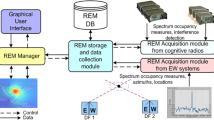Next Generation Wireless Networks (NGWNs) will allow the user to roam over different access networks, such as UMTS, Wi-Fi, satellite-based networks. Currently, these networks are integrated/assisted by more and more accurate navigation systems, which can make available the information on the location of the mobile terminal. This information is then typically used to provide location based services. This paper addresses a novel way of jointly using navigation and communication systems: the information on location together with other information on the situation of the user/network nodes is used in order to optimize the mobility and resource management over satellite/terrestrial heterogeneous networks.
Access this chapter
Tax calculation will be finalised at checkout
Purchases are for personal use only
Preview
Unable to display preview. Download preview PDF.
Similar content being viewed by others
References
C.A. Patterson, R.R. Muntz, C.M.Pancake,“Challenges in Location AwareComputing”, IEEE Pervasive Computing, pp. 80-89, April-June 2003.
S. Sharma, A.R. Nix, S. Olafsson,“Situation Aware Wireless Networks”, IEEECommunications Magazine, pp. 44-50, July 2003.
D. Jeong, Y.G. Kim, H.P. In, SA-RFID,“Situation-Aware RFID Architecture Analysisin Ubiquitous Computing”, Proceedingsof the 11th Asia-Pacific Software EngineeringConference (ASPEC 04).
Jian Ye, Jiongkuan Hou, S. Papavassiliou, “A Comprehensive Resource Management Framework for Next Generation Wireless Networks”, IEEE Transactions on Mobile Computing, vol. 1, no. 4, pp. 249-264, Oct.-Dec. 2002.
Siamak Naghian, “Location-Sensitive Radio Resource Management in Future Mobile Systems”, WWRF Results of NG4 May 10-11, 2001 of NG4 May 10-11, 2001.
J. Hightower, G. Borriello; “Location systems for ubiquitous computing.”, IEEE Computer, Volume 34, Issue 8, pp. 57-66, Aug. 2001.
A. Smith, H. Balakrishnan, M. Goraczko, and N. Priyantha; “Tracking Moving Devices with the Cricket Location System.”, MIT Computer Science and Artificial Intelligence Laboratory, http://nms.csail.mit.edu/cricket/
R. Want, A. Hopper, V. Falcão and J. Gibbons; “The Active Badge Location System.”, Olivetti Research Ltd. (ORL), Cambridge, England, 1992.
CambridgeUniversity Computer Laboratori, “The Bat ultrasonic location system”, http://www.cl.cam.ac.uk/Research/DTG/attarchive/bat/
N.B. Priyantha, A. Chakraborty, and H. Balakrishnan, “The Cricket Location-Support System”, Proceedings of the 6th Annual {ACM} International Conference on Mobile Computing and Networking (ACM MOBICOM), Boston, MA, August 2000.
Ron Weinstein, “RFID: A Technical overview and its applications to enterprise.”, IEEE IT Professional, Volume 7, Issue 3, pp. 27-33, May-June 2005.
D. Hahnel, W. Burgard, D. Fox, K. Fishkin, M. Philipose, “Mapping and localization with RFID technology”, Proceedings of the 2004 IEEE International Conference on Robotics & Automation, Volume 1, pp. 1015-1020 Vol.1, 2004.
S.S. Manapure, H. Darabi, V. Patel, P. Banerjee, “A Comparative Study of Radio Frequency-Based Indoor Location Sensing Systems.”, IEEE International Conference on Networking, Sensing and Control 2004, Volume 2, pp. 1265-1270 Vol.2, 2004.
Heikki Laitinen (editor), Suvi Ahonen, Sofoklis Kyriazakos, Jaakko Lähteenmäki, Raffaele Menolascino, Seppo Parkkila, “Cellular location technology.”, IST CELLO Project Deliverable, Document Id: CELLO-WP2-VTT-D03-007-Int, Nov. 2001.
N. Bulusu, J. Heidemann, D. Estrin, “GPS-less low-cost outdoor localization for Very Small Devices.”, IEEE Personal Communications, Volume 7, Issue 5, pp. 28-34, Oct. 2000.
Author information
Authors and Affiliations
Editor information
Editors and Affiliations
Rights and permissions
Copyright information
© 2008 Springer Science+Business Media, LLC
About this paper
Cite this paper
Cianca, E. et al. (2008). Integration of Navigation and Communication for Location and Context Aware RRM. In: Re, E.D., Ruggieri, M. (eds) Satellite Communications and Navigation Systems. Signals and Communication Technology. Springer, Boston, MA. https://doi.org/10.1007/978-0-387-47524-0_3
Download citation
DOI: https://doi.org/10.1007/978-0-387-47524-0_3
Publisher Name: Springer, Boston, MA
Print ISBN: 978-0-387-47522-6
Online ISBN: 978-0-387-47524-0
eBook Packages: EngineeringEngineering (R0)



